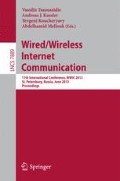Abstract
Mobility models are used to mimic the realistic movement of entities. Mobility models for wireless networks feature different objectives and characteristics, most based on random behaviour. However, random based mobility models, e.g. Random Waypoint (RWP), are often not suitable to represent the reality of node mobility, particularly in disaster areas where the search time for victims is a critical factor. Moreover, the studied mobility models for disaster environments are either random based or not suitable for such scenarios. This work proposes a new mobility model based on Human Behaviour for Disaster Areas (HBDA) to properly evaluate the performance of mobile wireless networks in disaster environments. HBDA is designed to cover as much area as possible, regarding search time as an important factor. This work evaluates HBDA concerning movement and link performances. Results show that HBDA provides an even distribution of nodes, a high coverage area and an efficient routing performance.
Access this chapter
Tax calculation will be finalised at checkout
Purchases are for personal use only
Preview
Unable to display preview. Download preview PDF.
References
Johnson, D., Maltz, D.: Dynamic source routing in ad hoc wireless networks. In: Mobile Computing (1996), http://www.springerlink.com/index/QG8843V474571123.pdf
Kumar, S., Sharma, S.C., Suman, B.: Mobility Metrics Based Classification & Analysis of Mobility Model for Tactical Network. International Journal of Next-Generation Networks 2(3), 39–51 (2010), http://www.airccse.org/journal/ijngn/papers/0910ijngn05.pdf
Bettstetter, C., Resta, G., Santi, P.: The Node Distribution of the Random Waypoint Mobility Model for Wireless Ad Hoc Networks 2(3), 257–269 (2003)
Bettstetter, C., Wagner, C.: The spatial node distribution of the random waypoint mobility model. In: German Workshop on Mobile Ad Hoc …(2002), http://citeseerx.ist.psu.edu/viewdoc/download?doi=10.1.1.93.1351&rep=rep1&type=pdf
Lim, S., Yu, C., Das, C.: Clustered Mobility Model for Scale-Free Wireless Networks. In: Proceedings of the 2006 31st IEEE Conference on Local Computer Networks, pp. 231–238 (November 2006), http://ieeexplore.ieee.org/lpdocs/epic03/wrapper.htm?arnumber=4116552
Hong, X., Gerla, M.: A group mobility model for ad hoc wireless networks (1999), http://citeseerx.ist.psu.edu/viewdoc/summary?doi=10.1.1.138.971
Sanchéz, M.: Mobility models @ONLINE, http://www.disca.upv.es/misan/mobmodel.htm (page last accessed in December 30, 2012)
Aschenbruck, N., Gerhards-Padilla, E., Gerharz, M., Frank, M., Martini, P.: Modelling mobility in disaster area scenarios. In: Proceedings of the 10th ACM Symposium on Modeling, Analysis, and Simulation of Wireless and Mobile Systems - MSWiM 2007, p. 4 (2007), http://portal.acm.org/citation.cfm?doid=1298126.1298131
Pomportes, S., Tomasik, J., Vèque, V.: A Composite Mobility Model for Ad Hoc Networks in Disaster Areas 1(1), 62–68 (2011)
Rhee, I., Shin, M., Hong, S., Lee, K., Chong, S.: On the Levy-Walk Nature of Human Mobility. In: 2008 IEEE INFOCOM - The 27th Conference on Computer Communications, pp. 924–932 (April 2008), http://ieeexplore.ieee.org/lpdocs/epic03/wrapper.htm?arnumber=4509740
OPNET, Opnet simulator (1986), http://www.opnet.com/
Jacquet, P., Mhlethaler, P., Clausen, T., Laouiti, A., Qayyum, A., Viennot, L.: Optimized link state routing protocol for ad hoc networks, pp. 62–68 (2001)
Author information
Authors and Affiliations
Editor information
Editors and Affiliations
Rights and permissions
Copyright information
© 2013 Springer-Verlag Berlin Heidelberg
About this paper
Cite this paper
Conceição, L., Curado, M. (2013). Modelling Mobility Based on Human Behaviour in Disaster Areas. In: Tsaoussidis, V., Kassler, A.J., Koucheryavy, Y., Mellouk, A. (eds) Wired/Wireless Internet Communication. WWIC 2013. Lecture Notes in Computer Science, vol 7889. Springer, Berlin, Heidelberg. https://doi.org/10.1007/978-3-642-38401-1_5
Download citation
DOI: https://doi.org/10.1007/978-3-642-38401-1_5
Publisher Name: Springer, Berlin, Heidelberg
Print ISBN: 978-3-642-38400-4
Online ISBN: 978-3-642-38401-1
eBook Packages: Computer ScienceComputer Science (R0)

